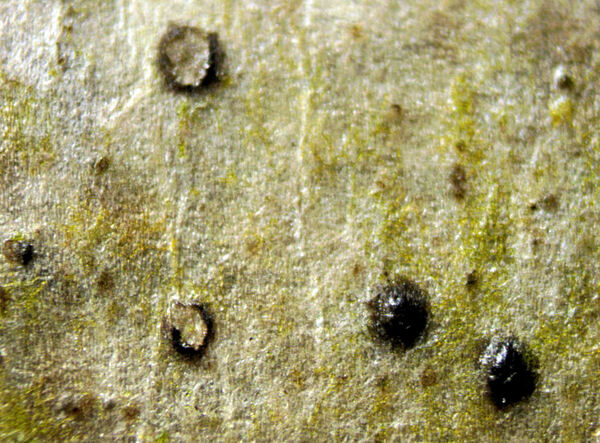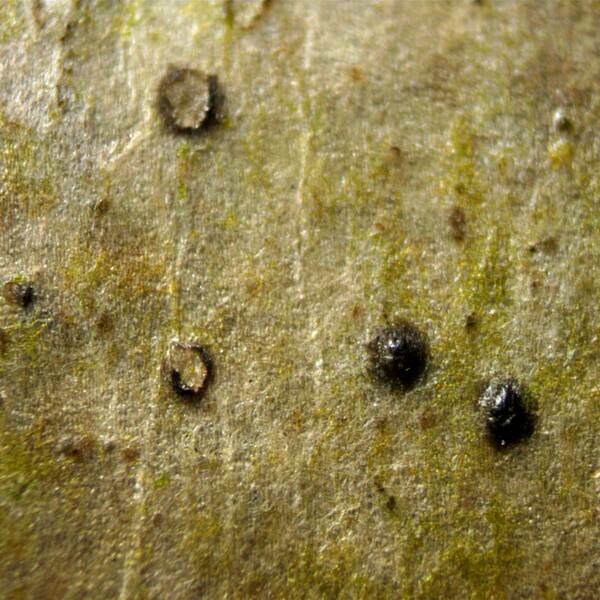Leptorhaphis maggiana (A. Massal.) Körb.
Parerga Lichenol.: 386, 1865. Basionym: Campylacia maggiana A. Massal. - Sched. Crit., 4: 74, 1856.
Synonyms: Campylacia quercus Beltr.; Leptorhaphis quercus (Beltr.) Körb.; Spermatodium maggianum (A. Massal.) Trevis.; Verrucaria maggiana (A. Massal.) Stizenb.
Description: Thallus inconspicuous, doubtfully lichenized, sometimes loosely associated algae near the perithecia. Perithecia reddish brown to black, shiny, smooth, scattered singly, circular to slightly ellipsoid, c. 0.13-0.3 mm across, at first immersed, later becoming superficial, hemispherical to flattened, sometimes mammiform, the ostiole centrally located in a small papilla. Involucrellum reddish brown to greenish-black, c. 15 μm thick, covering the exciple, rarely extending into a thin basal fringe, composed of bark material intermixed with reddish-brown to greenish-black, smooth, thin-walled c. 3.5-5.5 μm thick hyphae slightly constricted at septa, forming a clypeate tissue; exciple colourless to greenish-black, 5-8(-15) μm thick, slightly thicker at the angles of the perithecial cavity, intergrading with the involucrellum, consisting of colourless to greenish-black, thin-walled, isodiametrical cells with an enlarged lumen, forming a textura angularis; pseudoparaphyses 2-2.5 μm thick; hymenial gel I+ yellowish. Asci 8-spored, cylindrical-clavate, 50-55 x 9-11 μm, bi- and fissitunicate, with a broad, truncate apical beak. Ascospores 1(-3)-septate, thread-like, arcuate or sigmoid, helically twisted, (25-)30-45(-52) x 1.5-2.5 μm, attenuated at apices. Pycnidia black, shiny, circular to ellipsoid, scattered singly among the perithecia, 0.1-0.15 μm in diam., immersed to superficial, opening by a central ostiole, the wall dark brown to greenish-black. Microconidia hyaline, smooth, thin-walled, bacilliform, c. 3.75 x 1-1.5 μm; macroconidia 1-septate, hyaline, smooth, thin-walled, filiform, arcuate, c. 20-25 x 1-1.5 μm. Photobiont absent or thallus loosely associated with algae. Spot tests: K-, C-, KC-, P-, UV-. Chemistry: without lichen substances.
Growth form: Fungus
Substrata: bark
Reproductive strategy: mainly sexual
Pioneer species
Commonnes-rarity: (info)
Alpine belt: absent
Subalpine belt: absent
Montane belt: absent
Dry submediterranean belt: very rare
Humid submediterranean belt: absent
Padanian area: absent
pH of the substrata:
1 2 3 4 5
Solar irradiation:
1 2 3 4 5
Aridity:
1 2 3 4 5
Eutrophication:
1 2 3 4 5
Poleotolerance:
0 1 2 3
Altitudinal distribution:
1 2 3 4 5 6
Rarity
absent
extremely rare
very rare
rare
rather rare
rather common
common
very common
extremely common
Loading data...
Occurrence data
Predictive map
Growth form: Fungus
Substrata: bark
Reproductive strategy: mainly sexual
Pioneer species
Commonnes-rarity: (info)
Alpine belt: absent
Subalpine belt: absent
Montane belt: absent
Dry submediterranean belt: very rare
Humid submediterranean belt: absent
Padanian area: absent
pH of the substrata:
| 1 | 2 | 3 | 4 | 5 |
Solar irradiation:
| 1 | 2 | 3 | 4 | 5 |
Aridity:
| 1 | 2 | 3 | 4 | 5 |
Eutrophication:
| 1 | 2 | 3 | 4 | 5 |
Poleotolerance:
| 0 | 1 | 2 | 3 |
Altitudinal distribution:
| 1 | 2 | 3 | 4 | 5 | 6 |
Rarity
absent
extremely rare
very rare
rare
rather rare
rather common
common
very common
extremely common
Loading data...
Occurrence data
Predictive map








